stop start AUDI R8 SPYDER 2012 Owner's Manual
[x] Cancel search | Manufacturer: AUDI, Model Year: 2012, Model line: R8 SPYDER, Model: AUDI R8 SPYDER 2012Pages: 236, PDF Size: 59.24 MB
Page 157 of 236
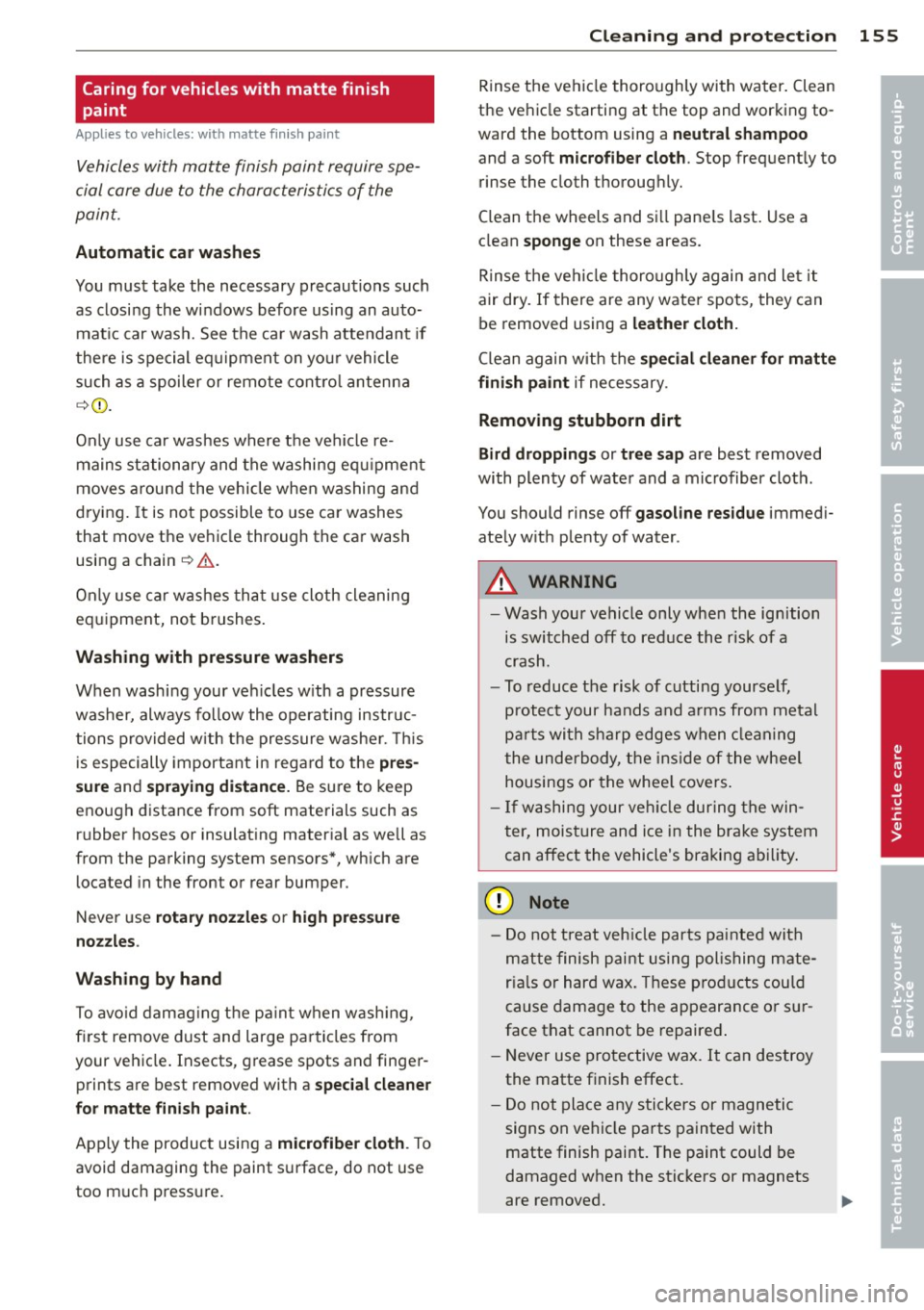
Caring for vehicles with matte finish
paint
Applies to vehicles: with matte finish paint
Vehicles with matte finish paint require spe
cial care due to the characteristics of the
paint.
Automatic car washes
You must take the necessary precautions such
as closi ng the windows before us ing an auto
mat ic car wash. See the ca r wash attendant if
the re is special eq uipment on yo ur vehicle
such as a spoiler or remote cont ro l an tenna
¢ 0 .
Only use ca r was hes where t he vehicle re
mains stationary and the washing eq uipment
moves around the vehicle when washing and
d rying.
It is not possible to use ca r washes
that move the ve hicle through the ca r wash
using a chain
~ .&. .
Only use car w ashes tha t use cloth cleaning
eq uipment, not brushes .
Washing with pressure washers
When washing your ve hicles w ith a pressure
washer, always follow the operating instruc
tions provided w ith the pressure washer. This
i s especially important in rega rd to t he
pre s
sure
and s praying di stance. Be su re to keep
enough distance from soft materials such as
rubber hoses or insulat ing mater ial as we ll as
from the parking system sensors*, wh ich are
loca ted in the front or rear bumper.
Never use
rotary nozzle s or high pre ssure
nozzles .
Washing by hand
To avo id damag ing t he pa int when w ash ing ,
firs t remove d ust and large pa rticles from
your vehicle . Insects, grease spots and finger
p rints a re best removed with a
special cleaner
for matte finish pa int .
Apply the produc t using a mi crofiber cloth . To
avoid damaging the paint surface, do not use
too m uch press ure.
Cleaning and protec tion 155
Rinse the ve hicle thoroughly wi th water. Clean
the ve hicle starting at t he top and working to
ward the bottom using a
neutral shampoo
and a soft microfiber cloth . Stop frequent ly to
rinse the cloth thoroughly.
Clean the wheels and si ll pane ls last. Use a
clean
sponge on these areas.
R inse t he ve hicle thoroughly again and le t it
air dry. If there are any water spots, they can
be removed using a
leathe r cloth.
Clean again with the spe cial cleaner for matte
finish paint
if necessary .
Removing stubborn dirt
Bird droppings or tre e sap
are best remov ed
with plenty of wate r and a microfiber cloth .
You should rinse off
gasoline res idue immed i
ate ly w ith plenty of water .
_& WARNING
-Wash your vehicle only whe n the ignition
is switched off to red uce the risk of a
cras h.
- To reduce the risk of c utting yourse lf,
protect your hands and a rms fro m meta l
pa rt s wi th sha rp edges when clea ning
the underbody, the ins ide of the whee l
housings or the whee l covers .
- If washing your ve hicle dur ing the win
ter, mois ture and i ce in the brake system
can affect the vehicle 's braking ab ility .
(D Note
-Do not treat veh icle parts pain te d wi th
m att e fini sh paint u sing pol ishing m ate
r ia ls or hard wax. These p rod ucts cou ld
cause damage to the appearance o r sur
face that cannot be repaired .
- N ever use protective wax . It ca n destroy
the matte finish effect.
- Do not pla ce an y s tickers or magnetic
signs on vehi cle pa rts painted with
matte finish paint. The paint could be
damaged when the stickers or magnets
are removed.
•
•
Page 203 of 236
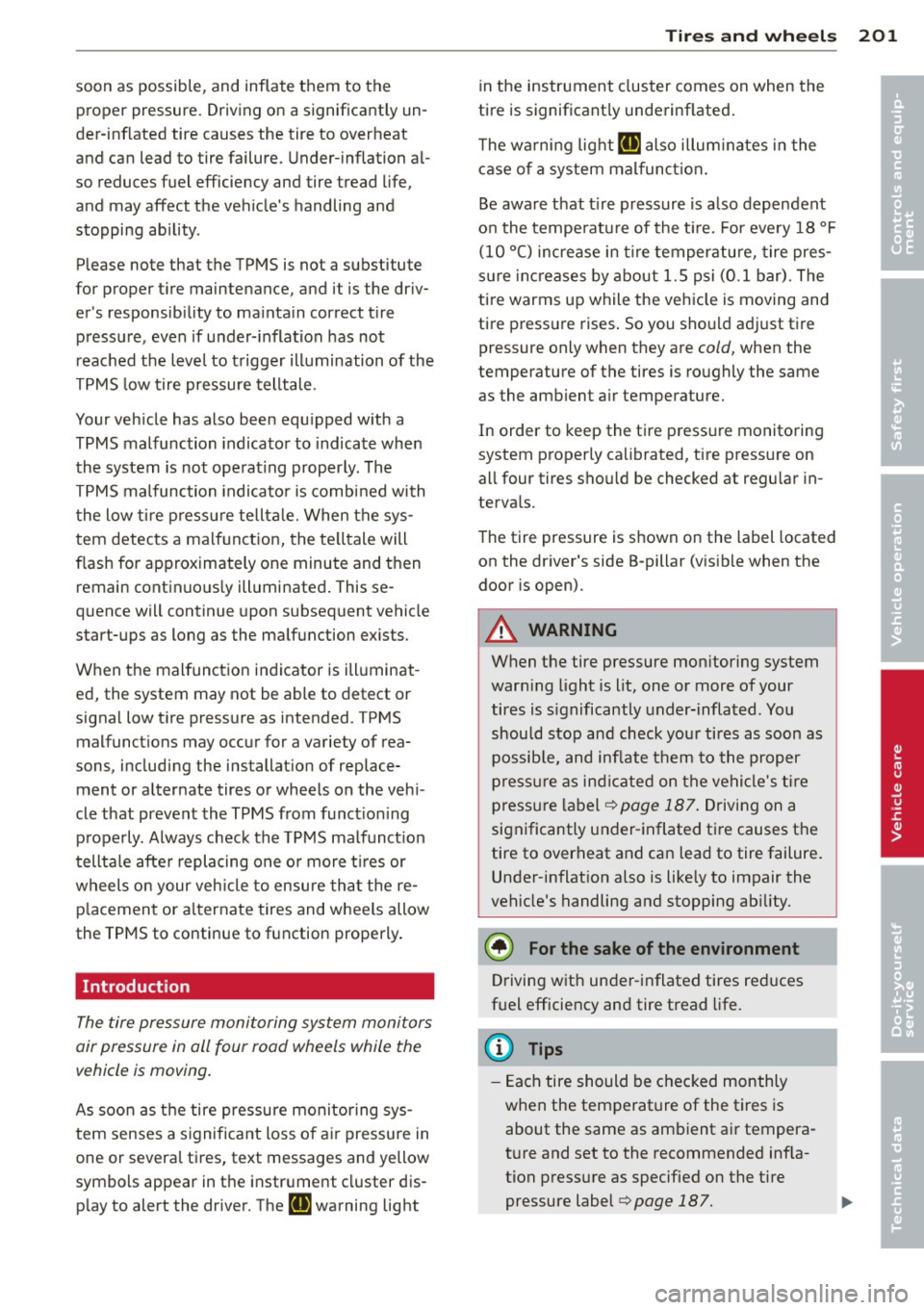
soon as possible, and inflate them to the
proper pressure . Driving on a significant ly un
der-inflated tire causes the tire to overheat
and can lead to tire failure. Under-inflation a l
so reduces fuel efficiency and tire tread l ife,
and may affect the veh icle 's handling and
stopping ab ility.
Please note that the TPMS is not a substitute
for proper t ire maintenance, and it is the dr iv
er's responsib ility to ma inta in correct t ire
p ress ure , even if under- inflation has not
reached the leve l to t rigger illumination of the
TPMS low tire pressure telltale .
Your veh icle has also been equ ipped with a
TPMS malfunction indicato r to indicate when
the system is not ope rating properly. The
TPMS malfunc tion indica to r i s combined wi th
the low t ire pr essu re tellta le. When the sys
tem detec ts a ma lf u nct ion, the te lltale will
flash for approximately one minute and then remain continuo usly ill uminated . This se
q uence will continue upon subsequent vehicle
start-ups as long as the malfunction ex ists.
When the malfunction indicator is ill uminat
ed, the system may not be able to detect or
signa l low t ire pressure as intended . TPMS
malfunct ions may occ ur for a variety of rea
sons, including the ins talla tio n of replace
ment or a lternate tires o r whee ls on the veh i
cle that prevent the TPMS from funct io ni ng
p roperly . Always check the TPMS malfunct ion
t ellta le afte r replacing one o r more t ires or
wheels o n your veh icle to ensure tha t the re
p lacemen t or a lternate tires and wheels allow
the TPMS to continue to function properly .
Introduction
The tire pressure monitoring system monitors
air pressure in all four road wheels while the
vehicle is moving .
As soon as the tire pressu re mo nitor ing sys
tem senses a s ignificant loss of a ir pressure in
one or severa l ti res, text messages and yellow
symbo ls appear in the instr ument cluster dis
p lay to alert the driver. The
[ti warning light
Tire s an d wheel s 201
in the instrument cluster comes on when the
ti re is significant ly underinflated .
T he wa rni ng lig ht
[ti also illu minates i n the
case of a system mal funct io n.
Be aware that t ire pressure is a lso dependent
o n the tempe ratu re of the t ire. For eve ry 18 ° F
(10 °C) incre ase in tir e te mper ature, tire pres
s u re inc reases by about 1.5 psi (0 .1 bar). The
ti re warms up while the ve hicle is moving and
tire p ress ure rises . So you sho uld ad just tire
pressure only when they a re
cold, when the
temperature of the tires is ro ughly the same
as the ambient a ir temperature.
In order to keep the tire press ure monito ring
system p roperly ca librated, t ire press ure on
all four tires sho uld be checked at regu lar in
terva ls.
The tire pressure is shown on the label located
on the dr iver's side B-pillar (v is ib le when the
door is open) .
A WARNING
When the tire pressure mo nitoring system
war ning light is lit , one o r m ore of your
tires is s ignificantly under-infla ted . You
shou ld stop and check your tires as soon as
pos sib le, and in flate t hem to the proper
p ress ure a s in dic ate d on the ve hicle's ti re
p ress ure lab el
¢page 187. Driving on a
significantly under -inflated ti re causes t he
tire to over heat and can lead to tire failure .
Under-inflat ion also is like ly to impair the
vehicle's handling and stopping ab ility.
@ For the sake of the environment
D riving wit h un der -inflated tires red uces
fuel efficiency an d tire t read life.
(D Tips
- E ach tire should be chec ked monthly
w hen the tem perature of the tires is
about the same as amb ient a ir tempera
t u re and set to the recommended infla
tion press ure as specified on the tire
pressure label¢
page 187.
•
•
Page 208 of 236

206 What do I do now?
• Switch the electric air pump off -switch in
position
0. If the required tire pressure of at
l east 1.8 bar has not been reached, it is not
poss ible to make a repa ir with the tire seal
ant. Seek professional ass istance.
Disassembling Tire Mobility System
• Remove the hose from the valve and pull
the p lug out of the socket .
• Screw the dust cap onto the valve.
• Place the empty sealant bottle back in the
original packaging and clip it in place under
the floor so that no tire sealant can run out into the vehicle .
• Start driving r ight away so that the sealant
is distributed in the tire.
.&_ WARNING
- Follow the manufactur er's safety instruc
tions on the decal for the air pump and
the sea lant bott le .
- If a tire pressure of 1.8 bar cannot be
achieved after pumping for 5 minutes,
the tire is too severely damaged. Do not continue to drive.
- Seek professional assistance if it is not
possible to repair the tire with the tire
sealant.
(D Tips
- Do not operate the electric air pump for
more than 8 min utes without stopping,
otherwise it can overheat. When the air
pump has cooled down, you can continue
to use it.
- If sealant has escaped, allow it to dry,
then you can peel it off.
Final check
After driving for a short distance, t ire pressure
must be checked .
• After driving for about 10 minutes, stop
and check the t ire pressure .
• If tire pressure is still at least 1.3 bar, in
flate the tire to specified p ressure (see driv
er's side B-pillar), drive to the next repair shop and have the tire and the sealant
bot
tle replaced.
• If tire pressure is less than 1.3 bar, the t ire
is too severely damaged. Do not continue to
drive. Seek professional assistance.
.&_ WARNING
If tire pressure is less than 1.3 bar after
driving for 10 minutes, the tire is too se
ve rely damaged. Do not continue to drive.
Seek professional assistance.
(D Tips
After a tire repair, have the sealant bottle
replaced at a dealership. This restores full
functionality to the Tire Mobility System .
What should I be
aware of when
changing a tire?
Tires with unidirectional tread design
-
Tires with unidirectional tread design must be
mounted with their tread pattern pointed the
right direction.
A unidirectional tire can be identified by ar
rows on the sidewall, which point in the direc
tion of the rotation. You must follow the
specified direction of rotation. This is necessa
ry in order for these tires to develop their op
timum characteristics regarding grip, road
noise, wear, and hydroplaning .
· Anti-theft wheel bolts
A special adopter is needed to turn the anti
theft wheel bolts.
Fig . 156 A nti-theft wheel bolts wit h adapte r
Page 213 of 236
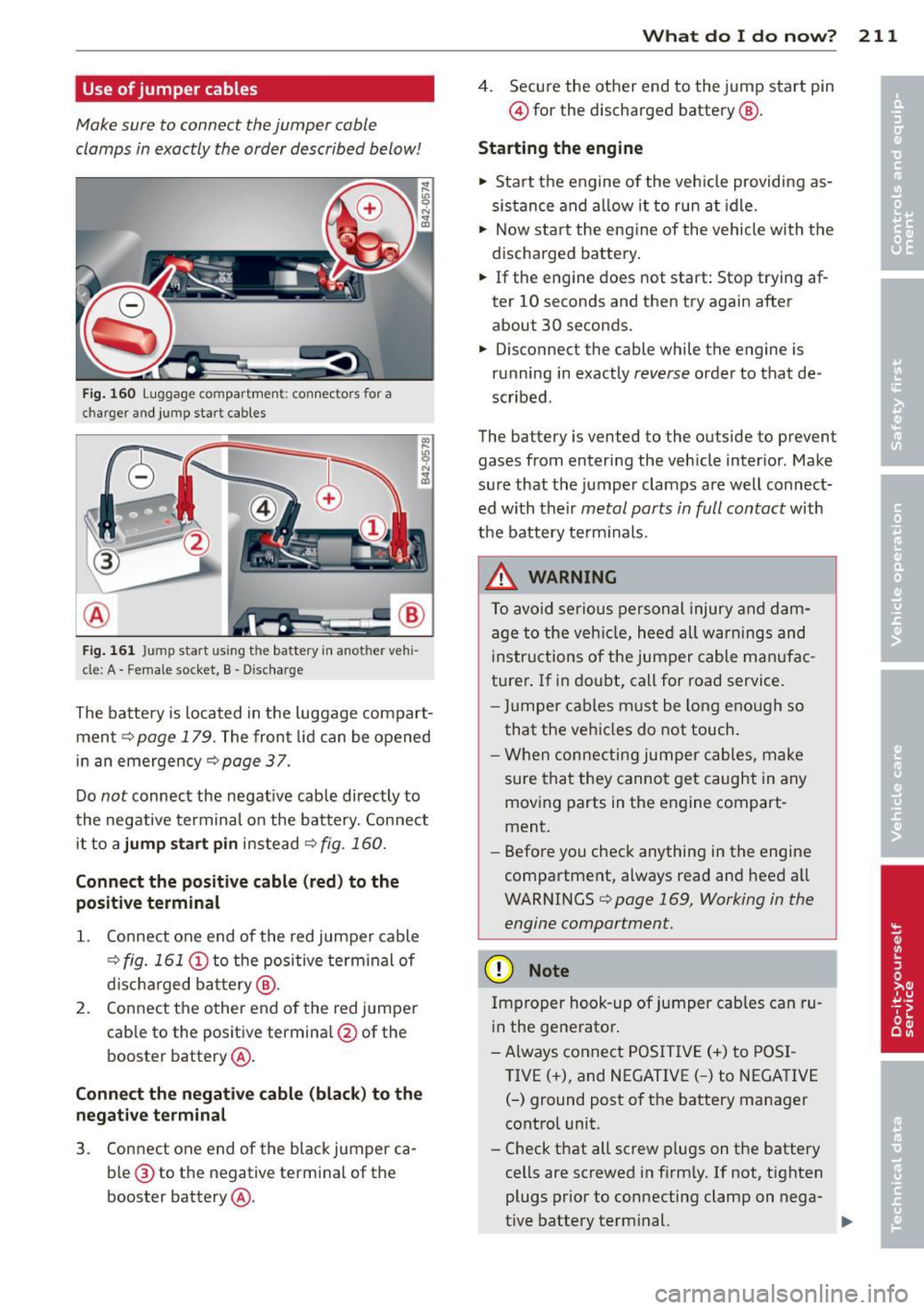
Use of jumper cables
Make sure to connect the jumper cable
clamps in exactly the order described below'
Fig . 160 Luggage co m pa rtme nt: connec tor s for a
ch arge r and jump start cab les
F ig . 161 Ju m p sta rt usin g t he batte ry in a not her ve hi
cl e:
A -Fem ale so cket , B · Di scharge
The batte ry is located in the luggage compart
ment
¢ page 179. The front lid can be opened
in an emergency
~page 37.
Do not connect the negat ive cable directly to
the negative termina l on the battery. Connect
it to a
j u mp start pin instead ¢ fig. 160.
Connect the posi tive cable (red) to the
positive t ermin al
1. Connect one end of the red jumper cable
¢ fig. 161 (D to the positive te rm inal of
d isc harged battery @.
2. Connect the other end of the red jumper
cable to the positive termina l@ of the
booster battery @.
Conn ect the negat ive cable (black ) to the
negati ve t erminal
3. Connect one end of the black jumper ca
b le @ to the negative terminal of the
booster battery @.
What do I d o now ? 211
4. Secu re the other end to the jump start pin
@ for the discharged battery @.
Starting the engine
~ Sta rt the engine of the veh icle providing as
sistance and al low it to run at idle.
~ Now sta rt the eng ine of the vehicle with the
discharged battery .
~ If the engine does not start: Stop trying af
ter 10 seconds and then try again after
about 30 seconds.
~ Disconnect the cable while the engine is
running in exactly
reverse order to that de
scribed .
The ba ttery is vented to the ou tside to prevent
gases from entering the veh icle inter ior . Make
sure that the jumper clamps are well connect
ed with their
metal parts in full contact with
the battery term inals .
.&, WARNING
To avoid serious person al injury and dam
age to the veh icle, heed all warnings and
instructions o f the jumper cable manufac
turer . If in doubt , call for road service.
- Ju mper cables m ust be long enough so
that the vehicles do not touch.
- When connecting jumper cables, make
sure that they canno t get caught in any
mov ing parts in the engine compart
ment.
- Before you check anything in the engine
compartment, always read and heed a ll
WARNINGS
¢ page 169, Working in the
engine compartment.
(D Note
Improper hook-up of jumper cables can ru
in the generator .
- Always co nnect POSITIVE(+) to POSI
TIVE(+), and NEGATIVE( -) to NEGATIVE
( - ) ground post of the battery manager
control unit.
- Check that all screw p lugs on the battery
cells are screwed in firm ly. If not, tighten
plugs prior to connecting clamp on nega-
-
tive battery term inal. .,..
Page 228 of 236
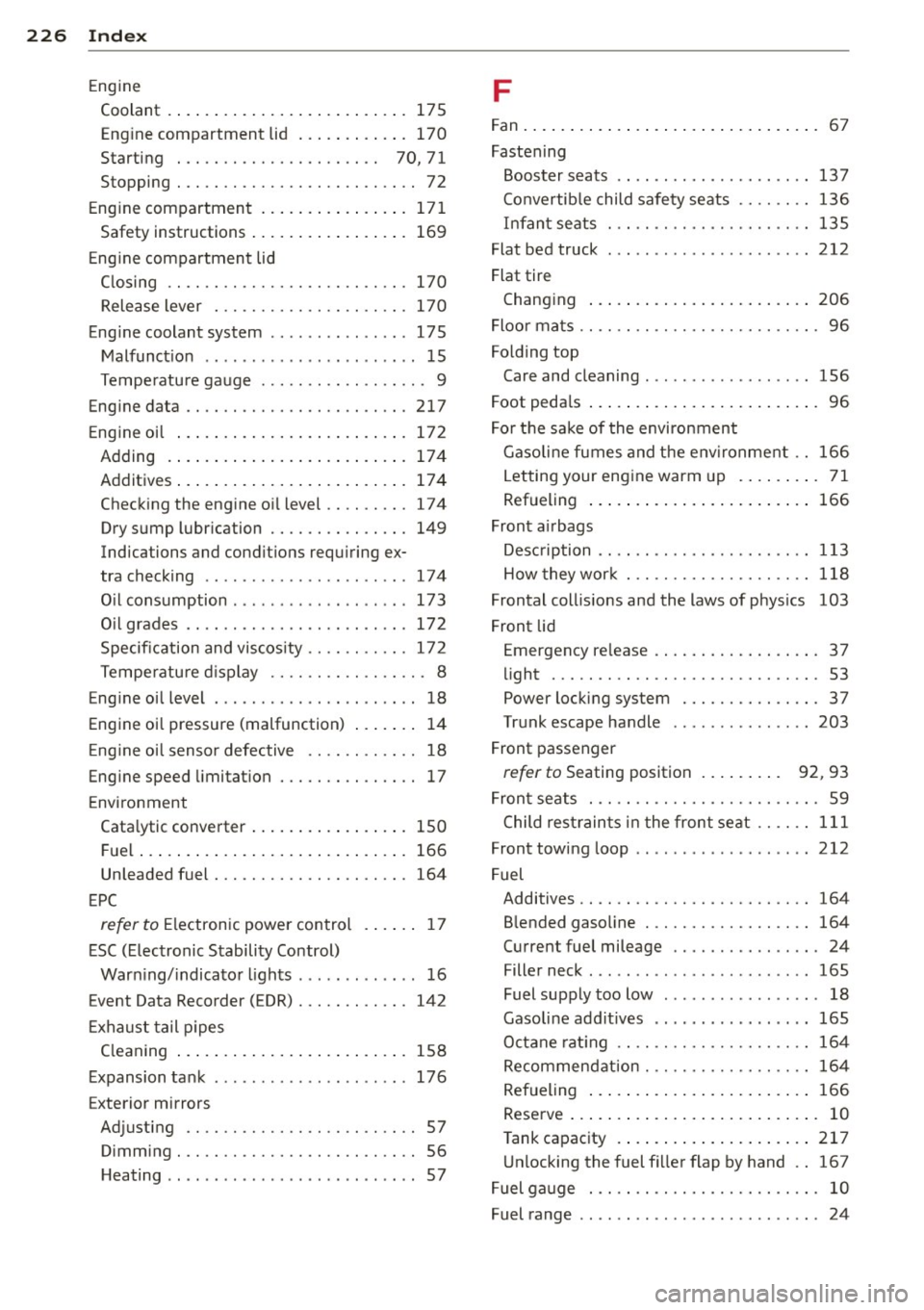
226 Index
Eng ine
Coolant . . . . . . . . . . . . . . . . . . . . . . . . . . 17 5
Eng ine compartment lid ... .. .. .... . 170
Starting . . . . . . . . . . . . . . . . . . . . . . 70, 71
Stopping . . . . . . . . . . . . . . . . . . . . . . . . . . 72
E ng ine compartment .. ... .. .. ... ... . 17 1
Safety instructions ..... ... .. .. .... . 169
E ng ine compartment lid
C losing ...... ........... .. .. .... . 170
Release lever .......... .. .. .. .. .. . 170
Eng inecoolantsystem ............... 175
Malfunct io n .................. ..... 15
Tempe ratu re ga uge .................. 9
Eng ine data ........................ 217
E ng ine oil ... .. . .. ..... ... .. .. .... . 17 2
Adding ..... .. .. ..... ... .. .. .... . 174
Additives ... ... . ...... ... .. .. .... . 174
Check ing the eng ine o il level . . . . . . . . . 17 4
Dry sump lubrication ............... 149
Indications and condit ions req uiring ex-
tra check ing . . . . . . . . . . . . . . . . . . . . . . 17 4
o·t t· 1 consump 10n .... ...... .. .. .. .. . 173
O il grades .. .......... ...... ... .. . 172
Specif ication and vi scos ity ... ... .. .. . 17 2
T empe ratu re d ispl ay ................. 8
Eng ine oil level ................. ..... 18
Engine oi l pressure (malfunction) ... .. . . 14
E ng ine o il sensor defective .. .. .. .. .. . . 18
Eng ine speed limitat ion ..... .. .. .... .. 17
E nvi ronment
Cata lytic conve rter ..... ... .. .. .... . 150
Fu el . .. .... ... . ...... ... .. .. .... . 166
Un leaded fuel .............. .. .... . 164
E PC
refer to Electronic power control . . . . . . 17
ESC (Elec tronic S tability Control)
War ning/ indica to r lights ....... .. .... 16
Event Data Recorder ( EDR) ... .... .... . 142
E xha ust tail p ipes
C leaning .... .. .. ..... ... .. .. .... . 15 8
E xp ansion ta nk .. .... ...... .. .. .. .. . 176
E xterior mirrors
Ad justing .. .. . .......... .. .. .... .. 57
o· . 1mming ... ............... ...... .. 56
H eating .. ................. ...... .. 57
F
Fan ... ... .. .... .. ... .. .. ..... ... .. . 67
Fasten ing
Boos ter seats .. .. .. ........ ...... . 137
Co nvertib le child safety seats ........ 136
Infan t se ats ... .. ... .......... .... 135
Flat bed truck ..... .......... ....... 212
Flat tire Changi ng ..... .. .... ...... ... .. .. 206
Floo r ma ts . . . . . . . . . . . . . . . . . . . . . . . . . . 96
Folding top
Care and cleaning . ................. 156
Foot peda ls ..... .. .. ... ..... ... .. .. . 96
F o r th e sake of the envi ronment
Gasoline fumes and the e nvir onme nt .. 166
L etting your eng ine warm up . ... .. .. . 71
Ref ueling ..... .. .. ... ..... ... .. .. 166
Front a irbags
Des cription .. .. .. ... .......... .. .. 113
How they wor k ................ .... 118
Frontal collis io ns and the laws of phys ics 103
Front lid
Emergency release .. ... ..... ... .. .. . 37
light . . . . . . . . . . . . . . . . . . . . . . . . . . . . . 53
Power locking system .......... ..... 37
Trunk escape handle ... ....... ... .. 203
F ront passenger
refer to Seating position . . . . . . . . . 92, 93
F ron t seats . . . . . . . . . . . . . . . . . . . . . . . . . 59
Childrest rain tsinthefrontseat ......
111
Front towing loop .................. . 212
Fuel Additives ......................... 164
B lended gaso line .............. .... 164
Current fuel mileage ................ 24
Filler neck ... .. .. .. ... ....... ... .. 16S
Fuel supply too low . . . . . . . . . . . . . . . . . 18
Gasoli ne addit ives ................ . 165
O ctane rat ing .. .. ... .......... .... 164
Recommendation .............. .. .. 164
Ref ueling ..... .. ... .. ..... .... . .. 166
Reserve ... .... .. .. ... ..... ... .. .. . 10
Tank capac ity .... ... .. ..... ... .. .. 217
Unlocking the fuel fi ller flap by hand .. 167
F uel gauge . .. .. .. ............. .... . 10
Fuel range . . . . . . . . . . . . . . . . . . . . . . . . . . 24
Page 232 of 236
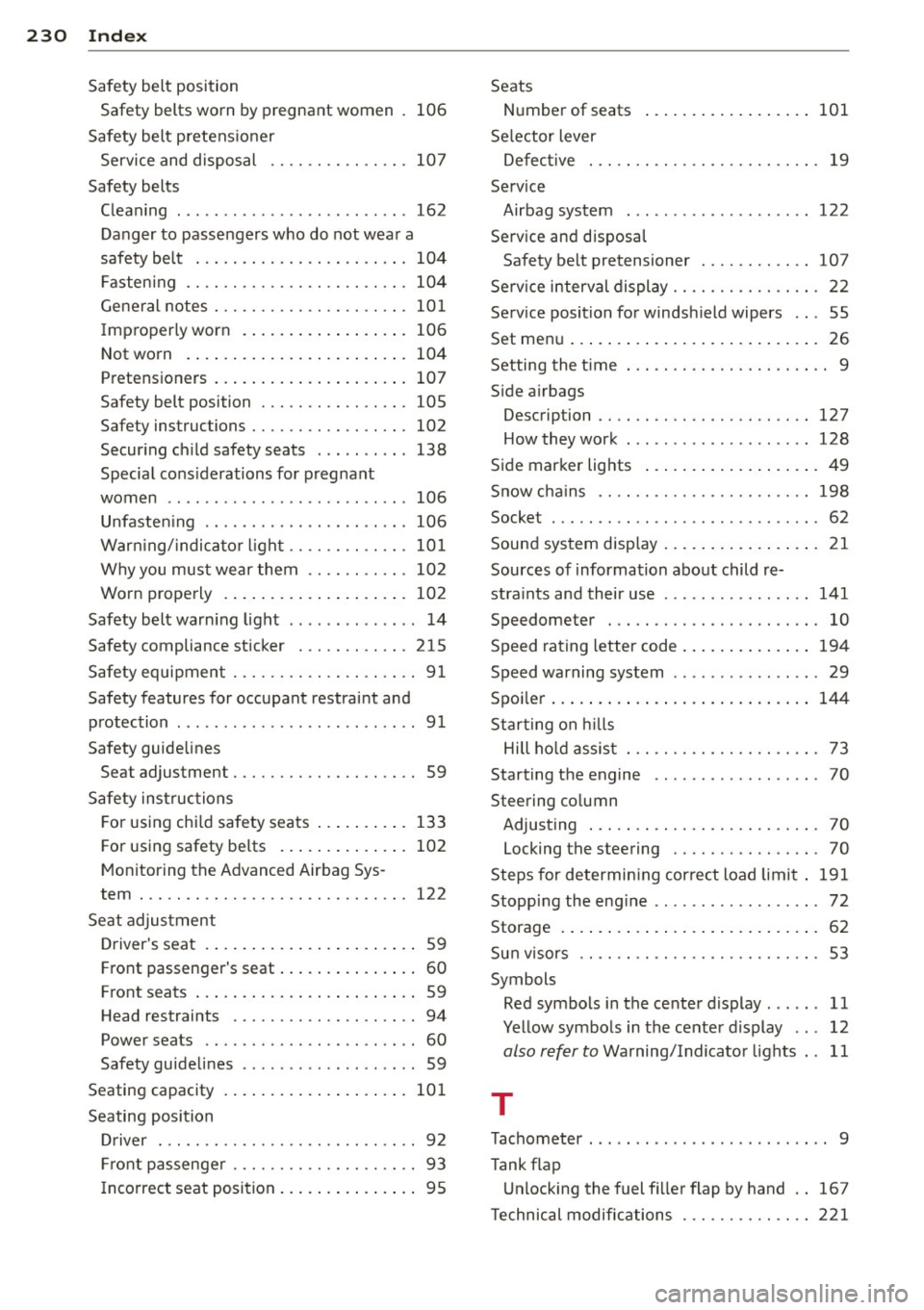
230 Index
Safety belt position Safety belts worn by pregnant women 106
Safety belt pretens io ner
Service and disposal .... .. .. .. .. .. . 107
Safety belts Cleaning . .. .......... ...... ... .. . 162
Danger to passengers who do not wear a
safety belt ............ .. .. .. .. .. . 104
F astening .... ........... .. .. .... . 104
General notes ............ .. .. .. .. . 101
I mproperly worn .......... ... .... . 106
Not worn . . . . . . . . . . . . . . . . . . . . . . . . 104
Pretensioners ................ .... . 107
Safety belt position . . . . . . . . . . . . . . . . 105
Safety instructions . . . . . . . . . . . . . . . . . 102
Securing child safety seats ....... .. . 138
Special cons iderations for pregnant
women .. .. ................ ... ... 106
Unfasten ing ........... .. .. .. .. .. . 106
Warn ing/ indicato r light ...... .. .... . 101
Why you must wear them .. .. .. .. .. . 102
Worn properly ............ ... .... . 102
Safety belt warn ing light ........ .. .. .. 14
Safety compliance sticker ..... .. .. .. . 215
Safety equipment ........ .. .. .. .. .. .. 91
Safety features for occupant restraint and protection . . . . . . . . . . . . . . . . . . . . . . . . . . 91
Safety guidelines Seat adjustment . . . . . . . . . . . . . . . . . . . . 59
Safety instructions For using chi ld safety seats .......... 133
F or using safety belts .............. 102
Monitoring the Advanced Airbag Sys-
tem ... .. ................. .. .... . 122
Seat adjustment Driver's seat . . . . . . . . . . . . . . . . . . . . . . . 59
Fr ont passenger's seat . . . . . . . . . . . . . . . 60
Front seats . . . . . . . . . . . . . . . . . . . . . . . . 59
Head restraints . . . . . . . . . . . . . . . . . . . . 94
Power seats . . . . . . . . . . . . . . . . . . . . . . . 60
Safety guidelines ..... .... .. .. .. .. .. 59
Seating capacity ............ ... .... . 101
Seating position
Driver . . . . . . . . . . . . . . . . . . . . . . . . . . . . 92
Fr ont passenger . . . . . . . . . . . . . . . . . . . . 93
I ncorrect seat position . . . . . . . . . . . . . . . 95 Seats
Number of seats
101
Selector lever
Defective ... .. .. ............. .. .. . 19
Serv ice
Airbag system ... ..... ........... . 122
Service and disposal Safety be lt pretensioner ........ .... 107
Serv ice interval display . . . . . . . . . . . . . . . . 22
Service position for windshield wipers .. . 55
Set menu ....... .. ................ .. 26
Setting the t ime ... ... .......... .. .. .. 9
Side airbags Descrip tion .... .. ... .......... .. .. 127
How they work . .. .......... ...... . 128
Side marker lights ................. .. 49
Snow cha ins .. .. . .. ............ .. .. 198
Socket . .... .... ................... . 62
Sound system display ................. 21
Sources of information about child re-
stra ints and their use . ........... .. .. 141
Speedometer . . . . . . . . . . . . . . . . . . . . . . . 10
Speed rating letter code .............. 194
Speed warning system . . . . . . . . . . . . . . . . 29
Spoi ler ............................ 144
Starting on hills
Hill hold assist ... ............. .... . 73
Starting the engine . . . . . . . . . . . . . . . . . . 70
Steering column Adjusting ..... .. ............. .... . 70
Locking the steering . . . . . . . . . . . . . . . . 70
Steps for determining correct load limit . 191
Stopping the eng ine ..... ........... .. 72
Storage ... ..... .. .. .............. .. 62
Sun visors .. .. .. .. .... ......... .... . 53
Symbols Red symbols in the center display ...... 11
Yellow symbols in the center display .. . 12
also refer to Warning/Indicator lights .. 11
T
Tachometer . . . . . . . . . . . . . . . . . . . . . . . . . . 9
Tank flap Unlocking the fuel filler flap by hand .. 167
T echnical modifications ........ .. .. .. 221